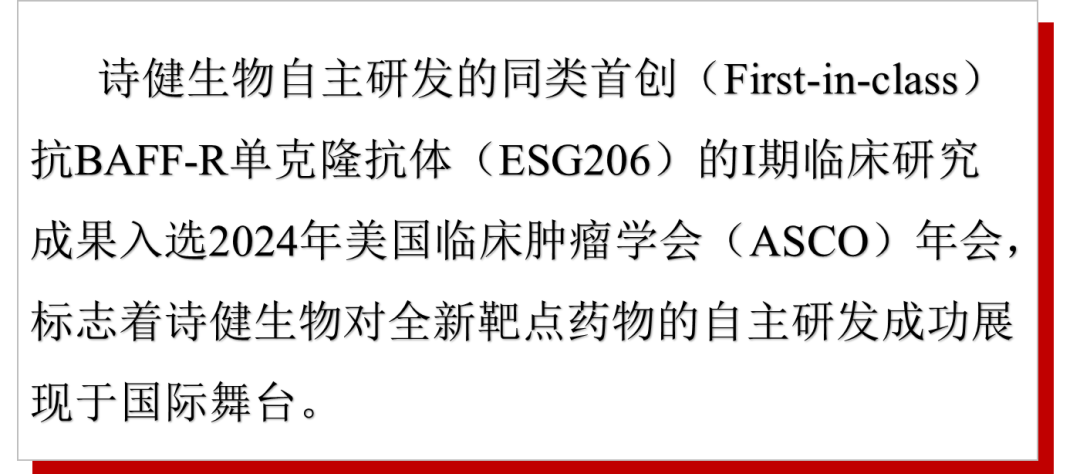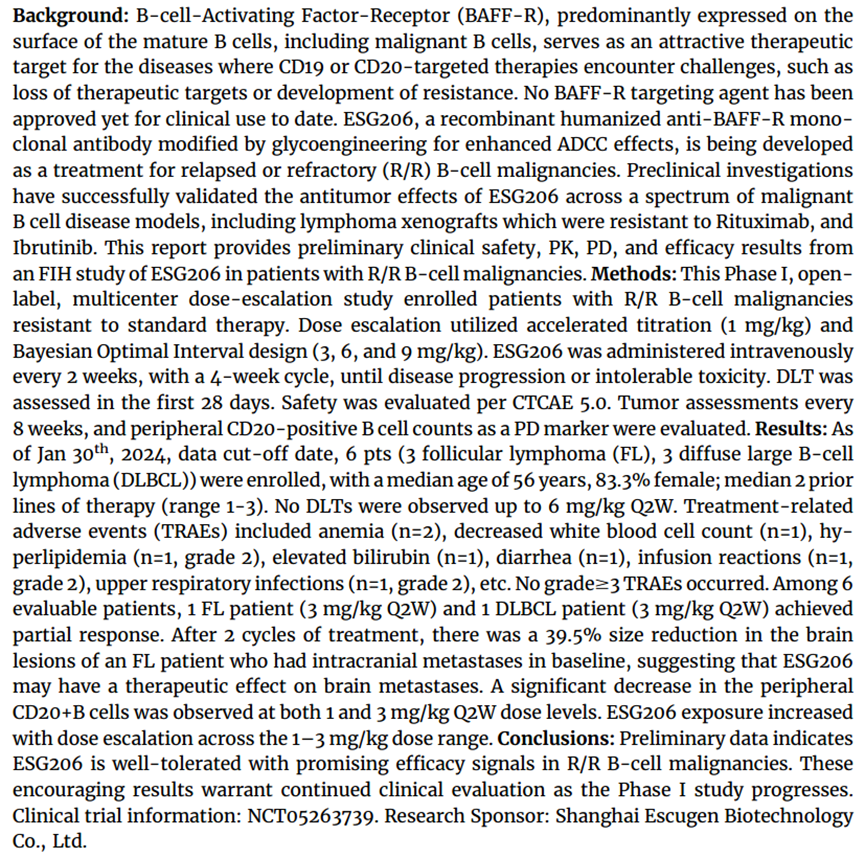


The B cell activating factor receptor BAFF-R (B cell activating factor of the TNF-family receptor) is a member of the TNF receptor superfamily, which is primarily involved in the development of B lymphocytes and the survival of mature B cells. BAFF-R is almost exclusively expressed on B cells; the highest expression levels of BAFF-R are found in CLL and MCL, and a significant proportion of patients with DLBCL, FL, and MZL also express BAFF-R. Therefore, it is a promising target for B cell malignancies. Additionally, this target holds great potential for the development of treatments for various autoimmune diseases. To date, no BAFF-R-targeted drugs have been approved for clinical use globally.
ESG206 Injection is a recombinant humanized anti-BAFF-R monoclonal antibody that exerts antitumor efficacy through antibody-dependent cell-mediated cytotoxicity (ADCC). Glycosylation modifications have significantly increased the content of non-fucosylated glycoforms in ESG206, thereby markedly enhancing ADCC activity in vitro. ESG206 is intended for the treatment of B cell lymphoma and chronic lymphocytic leukemia, particularly B lymphomas that are resistant to existing treatments. Furthermore, ESG206 will also explore the development and application in autoimmune diseases.
BAFF-R is mainly expressed on the surface of mature B cells (including malignant B cells) and is an attractive therapeutic target for challenges encountered with CD19 or CD20 targeted therapies (such as loss of therapeutic target or drug-resistant disease). To date, no drugs targeting BAFF-R have been approved for clinical use. Preclinical studies of ESG206 have successfully validated its antitumor effects in a range of malignant B cell disease models, including lymphomas resistant to rituximab and ibrutinib. This report provides preliminary clinical safety, pharmacokinetic (PK), pharmacodynamic (PD), and efficacy results from the first-in-human (FIH) study of ESG206 in patients with relapsed/refractory (R/R) B cell malignancies.
This Phase I, open-label, multicenter dose-escalation study enrolled patients with R/R B cell malignancies who were refractory to standard treatment. Dose escalation was conducted using an accelerated titration (1 mg/kg) and Bayesian Optimal Interval (BOIN) design (3, 6, and 9 mg/kg). ESG206 was administered intravenously every 2 weeks, with a 4-week treatment cycle, until disease progression or intolerable toxicity. Dose-limiting toxicity (DLT) was assessed within 28 days after the first dose. Safety was evaluated according to CTCAE 5.0. Tumor assessments were conducted every 8 weeks, and peripheral CD20-positive B cell counts were evaluated as pharmacodynamic (PD) indicators.
As of January 30, 2024, a total of 6 patients were enrolled, including 3 with follicular lymphoma (FL) and 3 with diffuse large B cell lymphoma (DLBCL), with a median age of 56 years. Female participants accounted for 83.3%, and the median number of previous treatment lines was 2 (range 1-3). The highest dose group has been observed up to 6 mg/kg Q2W without any DLT. Treatment-related adverse events (TRAEs) included anemia (n=2), leukopenia (n=1), hyperlipidemia (n=1, Grade 2), increased bilirubin (n=1), diarrhea (n=1), infusion reaction (n=1, Grade 2), and upper respiratory tract infection (n=1, Grade 2). No TRAEs of Grade ≥3 were reported.
Among the 6 evaluable patients for efficacy, 1 patient with FL (3 mg/kg Q2W) and 1 patient with DLBCL (3 mg/kg Q2W) achieved partial response. One FL patient with brain metastasis at baseline showed a 39.5% reduction in brain lesions after 2 cycles of treatment, indicating that ESG206 may have therapeutic effects on brain metastases. A significant reduction in peripheral CD20-positive B cells was observed at both 1 and 3 mg/kg Q2W dose levels. The exposure of ESG206 increased with dose escalation in the 1-3 mg/kg range.
Preliminary results suggest that ESG206 is well-tolerated in patients with R/R B cell malignancies and shows promising efficacy signals. As the Phase I study progresses, these encouraging results will be further clinically evaluated.
